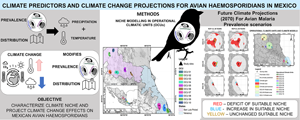Published online by Cambridge University Press: 10 May 2022

Long-term, inter-annual and seasonal variation in temperature and precipitation influence the distribution and prevalence of intraerythrocytic haemosporidian parasites. We characterized the climatic niche behind the prevalence of the three main haemosporidian genera (Haemoproteus, Plasmodium and Leucocytozoon) in central-eastern Mexico, to understand their main climate drivers. Then, we projected the influence of climate change over prevalence distribution in the region. Using the MaxEnt modelling algorithm, we assessed the relative contribution of bioclimatic predictor variables to identify those most influential to haemosporidian prevalence in different avian communities within the region. Two contrasting climate change scenarios for 2070 were used to create distribution models to explain spatial turnover in prevalence caused by climate change. We assigned our study sites into polygonal operational climatic units (OCUs) and used the general haemosporidian prevalence for each OCU to indirectly measure environmental suitability for these parasites. A high statistical association between global prevalence and the bioclimatic variables ‘mean diurnal temperature range’ and ‘annual temperature range’ was found. Climate change projections for 2070 showed a significant modification of the current distribution of suitable climate areas for haemosporidians in the study region.